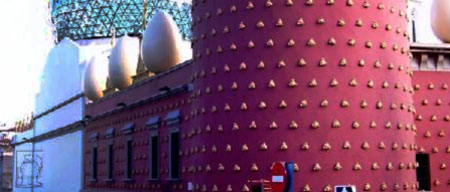Home > Study in Spain > City Guide > Girona
Girona City Guide
- Places of Interest
- Maps
- Getting to
- Getting around the city
Although less well known than its glamorous neighbour Barcelona, Girona is not a city to be dismissed. Its impressive medieval centre is reason enough to make a visit, as well as its historic Jewish quarter, full to the brim with museums, quaint bars and restaurants, picturesque cobbled streets and antique shops.
Situated in the north east of Spain, near the border with France, Girona is capital of the Catalonian province of the same name. It has an enjoyably mild climate, making it the perfect destination at any time of year. Only a stone's throw from Barcelona, the Costa Brava and the Pyrenees, you will be spoilt for choice in possible trips away, whether you are a city-slicker, a beach bum or an adrenaline-seeking snow-sports enthusiast.
The Roman town of Gerunda lay on the Via Augusta, on the route from Rome to Cádiz. The city came under Moorish and Frankish rule, before finally being declared a city in the 11th century by Alfonso I of Aragón. The 12th century saw a flourishing Jewish community in Girona, although this came to an end when all the Jews were expelled from Catalonia in 1492. Today, the Jewish ghetto is one of the best preserved in Europe and a major tourist attraction.
Girona is not your average tourist city; it has a peacefulness and tranquility difficult to find in many Spanish centres. It is impossible not to fall in love with this city of endless possibilities, from medieval ruins, to Botanical Gardens to outdoor sports. The city even boasts a Michelin starred restaurant! Why not come along and check it out for yourself?
Places of Interest
Arab Baths
Despite their deceptive name, these baths are actually 12th-century Romanesque. These are the only baths to be unearthed in Christian medieval Spain as the Muslim obsession with cleanliness meant it came to be almost seen as ungodly by Christians.
Cathedral
Although you have to climb 86 steps to reach this cathedral, it is well worth it, as this church has been said to be the finest example of Gothic architecture in Spain. Originally a Mosque, it was either remodeled or rebuilt after the expulsion of the Muslims. Inside is the widest Gothic nave in Europe and a beautiful collection of silverwork by the Valencian Pere Bernec. The museum adjacent to the cathedral houses the stunning Romanesque Tapestry of the Creation. This ticket also includes admission to an impressive 12th century cloister.
Collegiate Church of San Feliu
One of the few Spanish churches which possesses a genuine spire. 14th century gothic style with an 18th century façade.
Eiffel Bridge
One of Girona's 11 bridges, this is constructed at the point where four rivers meet. This is probably Girona's most famous bridge, and was constructed by Gustave Eiffel just before he built the Eiffel Tower in Paris. Cross over this bridge to reach a shopping street.
Monastery San Pere de Galligants
This ancient Benedictine Monastery offers spectacular views of the coast line below it. It dates back to the 13th century and is built in a Romanesque style. Its stunning austerity will mesmerize you.
Museums
Museum of the History of Jews (Museu d' Historia dels Jueus)
Girona's Jewish quarter is one of the best preserved in Europe, and this wonderful museum is certainly a highlight of the area. See engraved tombstones (translated from Hebrew into a variety of languages) and information about the day to day lives of Jews in the years before they were expelled in 1492; such as models demonstrating the way they dressed, or examples of the plaques they were required to leave outside their homes to indicate they were Jews. Another room is dedicated to the mathematicians and scientists that emerged in the community. An eye opening experience.
Cinema Museum (Museu Cinema)
Documenting the history of cinema from its very beginnings right up to film as we know it today. An Aladdin's cave of cinematic paraphernalia. Free entry for kids under 16.
Parks
Parc de la Devesa
The largest green area in the city. One side borders the river Ter, creating a haven for birdlife. The park has a sports area with an outdoor pool, changing rooms, free sun beds and a shady lawn area. There is even a small café and library area, where activities are run for children. It costs 18€ a day to visit the pool, although an annual pass can be bought for 165€. The park also boasts a variety of plant life, a kids play area, fountains and even some caged peacocks! During the summer months, late night bars are put up in the park.
Maps
Getting to Girona
By Air
There is a conveniently placed airport just 20 minutes south of the city which many budget airlines fly into.
By Bus
Girona is brilliantly connected with the whole of Catalonia and indeed the rest of Europe, with various bus lines serving the city. More information is available at www.ajuntament.gi/mobilitat.
By Train
Girona has equally good rail links, with many trains going in and out of Barcelona, as well as all over Spain and the rest of Europe. For more information visit renfe.es.
Getting around the city
Girona can be appreciated much better on foot. Many locals choose to cycle around the city, and there are many cycle routes marked. However, there are also several bus routes that operate around the city.
Tips
When walking around the Jewish quarter, wear flat, sturdy, comfortable shoes as the cobbled streets can cause problems without the right footwear.
The three Michelin-starred restaurant El Celler de Can Roca was voted the 5th best restaurant in the world in a recent review, and well worth a visit.

